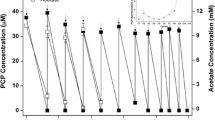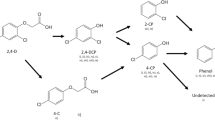Abstract
Biodegradation of 3,5,6-trichloro-2-pyridinol (TCP) in drylands is an important biological process of detoxification. Flooding in drylands can result in the formation of anaerobic habitats. However, little is known about the microbial metabolism of TCP in dryland soil under anaerobic conditions. Here, chlorpyrifos-contaminated dryland soil was incubated to enrich the TCP-degrading microbial consortium under anaerobic conditions. Chloridion and CO2 were released with TCP degradation, and the enrichment cultures of dryland soil could metabolize 97% of TCP (100 mg/L) within 20 h. Both reductive and hydrolysis dechlorination mechanisms were involved in TCP biodegradation under anaerobic conditions. Bacterial taxonomic analysis revealed that the aerobic TCP-degrading bacteria Ochrobactrum and dechlorination bacteria Delftia were the dominant genera. Anaerobic and facultative bacteria; i.e., Bacteroides, Bacillus, and Cupriavidus had lower relative abundances, but they were significantly enriched following treatment with TCP. These results indicate that the enrichment cultures of dryland soil dominated by aerobic bacteria could dechlorinate and degrade TCP under anaerobic conditions.






Similar content being viewed by others
References
Abraham J, Silambarasan S (2016) Biodegradation of chlorpyrifos and its hydrolysis product 3, 5, 6-trichloro-2-pyridinol using a novel bacterium Ochrobactrum sp. JAS2: a proposal of its metabolic pathway. Pestic Biochem Physiol 126:13–21
Anwar S, liaquat F, Khan QW, Khalid ZM, Igbal S (2009) Biodegradation of chlorpyrifos and its hydrolysis product 3, 5, 6-trichloro-2-pyridinol by Bacillus pumilus strain C2A1. J Hazard Mater 168(1):400–405
Cáceres T, He W, Naidu R, Megharaj M (2007) Toxicity of chlorpyrifos and TCP alone and in combination to Daphnia carinata: the influence of microbial degradation in natural water. Water Res 41(19):4497–4503
Cao L, Liu H, Zhang H, Huang K, Gu T, Ni H, Hong Q, Li SP (2012) Characterization of a newly isolated highly effective 3, 5, 6-Trichloro-2-pyridinol degrading strain Cupriavidus pauculus P2. Curr Microbiol 65(3):231–236
Chen K, Jian SS, Huang LL, Ruan ZP, Li SP, Jiang JD (2015) Reductive dehalogenation of 3, 5-dibromo-4-hydroxybenzoate by an aerobic strain of Delftia sp. EOB-17. Biotechnol Lett 37(12):2395–2401
Cui N, Wang S, Khorram MS, Fang H, Yu Y (2018) Microbial degradation of fomesafen and detoxification of fomesafen-contaminated soil by the newly isolated strain Bacillus sp. FE-1 via a proposed biochemical degradation pathway. Sci Total Environ 616–617:1612–1619
Eschbach M, Möbitz H, Rompf A, Jahn D (2003) Members of the genus Arthrobacter grow anaerobically using nitrate ammonification and fermentative processes: anaerobic adaptation of aerobic bacteria abundant in soil. FEMS Microbiol Lett 223(2):227–230
Feng Y, Racke KD, Bollag JM (1997) Isolation and characterization of a chlorinated-pyridinol-degrading bacterium. Appl Environ Microbiol 63(10):4096–4098
Feng Y, Minard RD, Bollag JM (1998) Photolytic and microbial degradation of 3, 5, 6-trichloro-2-pyridinol. Environ Toxicol Chem 17:814–819
Feng F, Ge J, Li Y, He S, Zhong L, Yu X (2017) Enhanced degradation of chlorpyrifos in rice (Oryza sativa L.) by five strains of endophytic bacteria and their plant growth promotional ability. Chemosphere 184:505–513
Gao ZM, Xu X, Ruan LW (2014) Enrichment and characterization of an anaerobic cellulolytic microbial consortium SDQ-1.1 from mangrove soil. Appl Microbiol Biotechnol 98(1):457–474
Han L, Zhao D, Li C (2015) Isolation and 2, 4-D-degrading characteristics of Cupriavidus campinensis BJ71. Braz J Microbiol 46(2):433–441
Jabeen H, Iqbal S, Anwar S (2015) Biodegradation of chlorpyrifos and 3, 5, 6-trichloro-2-pyridinol by a novel rhizobial strain Mesorhizobium sp. HN3. Water Environ J 29(1):151–160
Kaya D, Imamoglu I, Sanin FD, Sowers KR (2018) A comparative evaluation of anaerobic dechlorination of PCB-118 and Aroclor 1254 in sediment microcosms from three PCB-impacted environments. J Hazard Mater 341:328–335
Kim JR, Ahn YJ (2009) Identification and characterization of chlorpyrifos-methyl and 3, 5, 6-trichloro-2-pyridinol degrading Burkholderia sp. strain KR100. Biodegradation 20(4):487–497
Li JQ, Liu J, Shen WJ, Zhao XL, Hou Y, Cao H, Cui ZL (2010) Isolation and characterization of 3, 5, 6-trichloro-2-pyridinol-degrading Ralstonia sp. strain T6. Bioresour Technol 101(10):7479–7483
Li JQ, Huang Y, Hou Y, Li XM, Cao H, Cui ZL (2013) Novel gene clusters and metabolic pathway involved in 3,5,6-Trichloro-2-Pyridinol degradation by Ralstonia sp. Strain T6. Appl Environ Microbiol 79(23):7445–7453
Liu Z, Yang C, Qiao CL (2007) Biodegradation of p-nitrophenol and 4-chlorophenol by Stenotrophomonas sp. FEMS Microbiol Lett 277(2):150–156
Lü Z, Lu YH (2012) Methanocella conradii sp. nov., a thermophilic, obligate hydrogenotrophic methanogen, isolated from Chinese rice field soil. PLoS ONE 7:35279
Lu P, Li QF, Liu HM, Feng ZZ, Yan X, Hong Q, Li SP (2013) Biodegradation of chlorpyrifos and 3, 5, 6-trichloro-2-pyridinol by Cupriavidus sp. DT-1. Bioresour Technol 127:337–342
Manickam N, Reddy MK, Saini HS, Shanker R (2008) Isolation of hexachlorocyclohexane-degrading Sphingomonas sp. by dehalogenase assay and characterization of genes involved in gamma-HCH degradation. J Appl Microbiol 104(4):952–960
Olaniran AO, Igbinosa EO (2011) Chlorophenols and other related derivatives of environmental concern: properties, distribution and microbial degradation processes. Chemosphere 83(10):1297–1306
Racke KD (1993) Environmental fate of chlorpyrifos. Rev Environ Contam Toxicol 131:1–150
Rayu S, Nielsen UN, Nazaries L, Singh BK (2017) Isolation and molecular characterization of novel chlorpyrifos and 3, 5, 6-trichloro-2-pyridinol-degrading bacteria from sugarcane farm soils. Front Microbiol 8:518
Rios-Covian D, Gueimonde M, Duncan SH, Flint HJ, de los Reyes-Gavilan CG (2015) Enhanced butyrate formation by cross-feeding between Faecalibacterium prausnitzii and Bifidobacterium adolescentis. FEMS Microbiol Lett 362(21):1–7
Shiratori H, Ohiwa H, Ikeno H, Ayames S, Kataoka N, Miya A, Beppu T, Ueda K (2008) Lutispora thermophila gen. nov., sp. nov., a thermophilic, spore-forming bacterium isolated from a thermophilic methanogenic bioreactor digesting municipal solid wastes. Int J Syst Evol Microbiol 58:964–969
Shu DT, He YL, Yue H, Wang QY (2016) Metagenomic and quantitative insights into microbial communities and functional genes of nitrogen and iron cycling in twelve wastewater treatment systems. Chem Eng J 290:21–30
Singh BK, Walker A (2006) Microbial degradation of organophosphorus compounds. FEMS Microbiol Rev 30(3):428–471
Singh BK, Walker A, Morgan JA, Wright DJ (2004) Biodegradation of chlorpyrifos by Enterobacter strain B-14 and its use in bioremediation of contaminated soils. Appl Environ Microbiol 70:4855–4863
Tas DO, Pavlostathis SG (2005) Microbial reductive transformation of pentachloronitrobenzene under methanogenic conditions. Environ Sci Technol 39(21):8264–8272
Tiwari MK, Guha S (2014) Kinetics of biotransformation of chlorpyrifos in aqueous and soil slurry environments. Water Res 51:73–85
Wang SH, Zhang C, Yan YC (2012) Biodegradation of methyl parathion and p-nitrophenol by a newly isolated Agrobacterium sp. strain Yw12. Biodegradation 23(1):107–116
Wang SH, Zhang C, Li K, Qu J, Shi YH, Yan YC (2013) Chlorpyrifos-induced stress response in the chlorpyrifos-degrader Klebsiella sp. CPK. Int Biodeter Biodegr 82:17–23
Wilson FP, Liu X, Mattes TE, Cupples AM (2016) Nocardioides, Sediminibacterium, Aquabacterium, Variovorax, and Pseudomonas linked to carbon uptake during aerobic vinyl chloride degradation. Environ Sci Pollut Res Int 23(19):19062–19070
Wu ZG, Wang F, Ning LQ, Stedtfeld RD, Yang ZZ, Cao JG, Sheng HJ, Jiang X (2017) Biodegradation of 5-chloro-2-picolinic acid by novel identified co-metabolizing degrader Achromobacter sp. f1. Biodegradation 28(2-3):139–144
Xu GM, Li YY, Zheng W, Peng X, Li W, Yan YC (2007) Mineralization of chlorpyrifos by co-culture of Serratia and Trichosporon spp. Biotechnol Lett 29(10):1469–1473
Xu GM, Zheng W, Li YY, Wang SH, Zhang JS, Yang YC (2008) Biodegradation of chlorpyrifos and 3, 5, 6-trichloro-2-pyridinol by a newly isolated Paracoccus sp. strain TRP. Int Biodeter Biodegr 62(1):51–56
Xue L, Feng X, Xu Y, Li X, Zhu M, Xu J, He Y (2017) The dechlorination of pentachlorophenol under a sulfate and iron reduction co-occurring anaerobic environment. Chemosphere 182:166–173
Yoon H, Leibeling S, Zhang CY, Müller RH, Werth CJ, Zilles JL (2014) Adaptation of Delftia acidaovorans for degradation of 2, 4-dichlorophenoxyacetate in a microfluidic porous medium. Biodegradation 25(4):595–604
Zhang C, Yuan Q, Lu YH (2014) Inhibitory effects of ammonia on methanogen mcrA transcripts in anaerobic digester sludge. FEMS Microbiol Ecol 87(2):368–377
Acknowledgements
This study was supported by the National Natural Science Foundation of China (Grant Nos. 41401288 and 41501251), Science and Technology and Culture Innovation Fund (Grant Nos. 26312160910 and 26312170904) for College Students of Liaocheng University and the Shandong Provincial Natural Science Foundation of China (ZR2018BH043).
Author information
Authors and Affiliations
Corresponding author
Ethics declarations
Conflict of interest
The authors declare that they have no conflict of interest.
Additional information
Publisher's Note
Springer Nature remains neutral with regard to jurisdictional claims in published maps and institutional affiliations.
Rights and permissions
About this article
Cite this article
Wang, S., Zhang, C., Lv, Z. et al. Degradation of 3,5,6-trichloro-2-pyridinol by a microbial consortium in dryland soil with anaerobic incubation. Biodegradation 30, 161–171 (2019). https://doi.org/10.1007/s10532-019-09873-y
Received:
Accepted:
Published:
Issue Date:
DOI: https://doi.org/10.1007/s10532-019-09873-y




